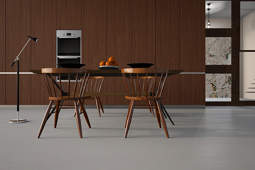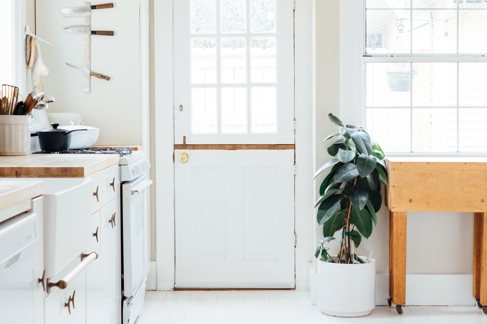
Technology, heating and appliances
Project type
If you are planning some home improvements, an extension, or a full renovation, this is a great time to focus on the appliances and technology in your home. It's probably years since your lighting, heating, hot water, and ventilation systems were installed and there are great opportunities to upgrade to systems that work better and cost less to run.
Heating
- Heating probably accounts for up to 40% of your energy bills so it might be time to consider replacing yours with something more efficient.
- Having an efficient heating system running on a low-carbon fuel is one of the most important steps you can take to reduce your fuel bills and your carbon dioxide emissions. You can find lots of information at The Energy Saving Trust
- If we are to reach the net zero carbon emissions target set by the UK Government, we will need to reduce the carbon emissions from heating our homes by 95% over the next 30 years.
- It is estimated that the average household generated 2,690kg of carbon dioxide (CO2) from space heating and hot water heating in 2020. By 2050, we need to reduce this to just 140kg per household. That’s a bold target but the recent increase in energy prices is focusing our attention on efficiency and if we all take some small steps, real change is possible.
- In the meantime, there is a lot you can do right now to make your heating system more energy efficient, saving yourself money on your fuel bills and reducing your carbon emissions.
Boilers
- Modern, well-maintained boilers burn their fuel relatively efficiently, but they inevitably lose some heat in the hot gases that escape up the flue (the pipe that extracts fumes from and supplies fresh air to your boiler).
- If your boiler is fairly new, the chances are it’s a condensing boiler. This recovers more heat from the exhaust flue gas and uses it to heat the central heating water, making it more efficient than older boilers. Since 2005, virtually all gas boilers that have been fitted in the UK are condensing boilers. Your boiler will be a condensing boiler if the flue is made of plastic. If it’s made of metal, it’s unlikely to be a condensing boiler. It will also have a plastic pipe coming out of the bottom, through the wall and into a drain.
- There is much talk about gas, oil and LPG boilers being banned in the future. This will start with a ban in new homes from 2025.
- If it’s time to change your boiler, or if you’re thinking ahead for when it needs to be replaced, you’ll need to decide what type of heating system is right for you. You might want to look at switching to a low or zero-carbon emission heating system, like a heat pump.
- There are different types of heating and hot water boilers which suit different households and types of homes.
- Gas and oil boilers are either ‘system’ boilers, with a separate hot water cylinder for storing hot water, or ‘combi’ boilers, which heat hot water on demand and don’t need a hot water cylinder – useful if you are short on space.
- A system boiler is actually more efficient than a combi boiler at producing hot water, but you’ll lose some heat from the hot water cylinder even if it is lagged with insulation.
- Combi boilers could be more efficient overall, although if you are installing solar water panels, you’ll need a hot water cylinder to store the generated energy.
- Large families using lots of hot water may prefer a system boiler, whereas smaller households using less hot water may be better off with a combi boiler.
- Are you thinking about installing a heat pump in the future? Bear in mind that most heat pumps work with a hot water cylinder, so if you get rid of your existing cylinder and fit a combi boiler, you might need to fit a new one if you switch to a heat pump in the future.
Maintenance and improvements
- You may be able to improve your existing central heating.
- Heating controls have changed and improved enormously in recent years. They can help your heating system work more efficiently and keep your bills down. Fitting room thermostats and thermostatic radiator valves (TRVs) help you to maintain different temperatures in different rooms. However, generally, it is advisable to not fit a TRV on the radiator located nearest the wall mounted thermostat.
- New hot water cylinders are factory insulated to help keep your hot water at the right temperature for longer. If yours isn’t insulated and doesn’t need replacing, you can fit an insulated jacket. You could save around £70 a year by topping up the insulation to 80mm.
- You can save energy by ensuring that the thermostat on your hot water cylinder is set between 60oC and 65o If the temperature is set above 65°C, then the water may be too hot to use and it increases the risk of serious burns. However, if the temperature is below 50°C, there’s an increased risk of growing bacteria, such as Legionella – this is most likely to happen when low water temperatures are combined with low water use.
- If you are replacing your cylinder, you can save energy by making sure the cylinder is no bigger than you need it, and of course well insulated with a factory-fitted foam jacket.
- Ask your plumber or heating engineer about prolonging the life of your system and improving efficiency by using chemical inhibitors. Corrosion in an older central heating system and the build-up of scale and sludge (rust) can reduce the effectiveness of the radiators, and the heating system. Chemical inhibitors can decrease the corrosion rate and prevent the build-up of sludge and scale. Inhibitors should be topped up or replaced whenever the heating system is drained during maintenance work or boiler replacement.
- You can add also add magnetic filters to remove rust from the heating water. If your boiler is replaced or swapped for another type of heating system, your plumber should fit a magnetic filter near the boiler.
- If you have a condensing combi-boiler, you can also save energy by tweaking the heat flow temperature that controls the temperature that your boiler heats water up to, before sending it off to your radiators. When your boiler is installed the flow temperature is usually set to around 70°C-80°C. This is too high for most combi boilers to run at maximum efficiency. Lowering your heating flow temperature from 80oC to 60oC may save you 6-8% gas.
- Depending on the type of boiler you have installed, you may also be able to add ‘weather compensation’. Weather compensation is a way of controlling your boiler based on the temperature outside by monitoring the indoor and outdoor temperatures. Weather compensation regulates and maintains an optimum flow temperature, and will become hotter if the outside temperature declines, and vice versa.
Renewable energy
Heat pumps
- You’ve probably heard of both ground and air-source heat pumps.
- Ground source heat pumps make use of the heat that occurs naturally in the ground. It is extracted from your garden via pipes. Ground source heat pumps are installed either using shallow horizontal trenches or deep vertical boreholes. If installing a horizontal system, you'll need a relatively large garden to house the pipes which run backward and forwards. You’ll also never be able to extend over that area so plan ahead. Alternatively, if you have limited space, a vertical system can be used – but this is typically a more expensive solution.
- There are two main types of air source heat pumps:
-Air to air heat pumps, which absorb heat from the outside air and then transfer it directly into your home via a fan system to heat a room.
-Air to water heat pumps, which absorb heat from the outside air and then transfer it via your central heating system to provide hot water heating, radiator, or underfloor heating in an indoor space (or all three).
- An air source heat pump can also heat water stored in a hot water cylinder for your washing, showers, and baths. Surprisingly there is still heat available to store when outside temperatures fall as low as minus 15 degrees.
- The main disadvantage is that visually the units are not very attractive and need to be sited close to but outside your home. The best location is a sunny wall with plenty of airflow and space around it. It is also worth bearing in mind that, generally speaking, your Local Planning Authority will require all parts of the air source heat pump to be at least 1m from the property boundary.
- They deliver heat at lower temperatures than gas and oil boilers. So you'll need to run them for much longer periods to heat your home to a comfortable temperature. You generally need larger radiators that feel less hot to the touch than with a traditional central heating system. The flow temperatures are usually set to no more than 55o
- A well-insulated home is essential – otherwise the heat the pump generates escapes more easily and you may find the temperature doesn't get up to a level you're used to. It may be less advantageous to fit a heat pump to a period home as they tend to be less airtight.
- Heat pumps will save you more on your heating bills if you're replacing an expensive system such as electric storage heaters, oil, LPG (liquefied petroleum gas) or coal.
- If you're replacing a gas boiler you won't see as big a cost saving - though you will still be considerably lowering your carbon emissions.
- Some air source heat pumps can also work as a cooling system in the summer months – but this needs to be carefully designed by a specialist to avoid the risk of interstitial condensation occurring, particularly if your property has underfloor heating.
- You can find more information about heat pumps at The Energy Saving Trust.
Solar water heating
- Solar water heating systems, also known as solar thermal, use heat from the sun to warm up water for your home. The system uses solar panels or collectors, which are fitted onto your roof. The panels collect the heat from the sun and use it to heat up water in a cylinder.
- You’ll need around five square metres for the panels, ideally on a south-facing roof in a sunny location.
- You can also mount solar panels fixed to a frame on a flat roof or hung from a wall.
- You will also need space for an additional or increased size hot water cylinder.
- Because the amount of available solar energy varies throughout the year, a solar water heating system won’t provide 100% of the hot water you need throughout the year. You’ll probably need another form of water heating or immersion heater.
- It is possible to fit much larger solar hot water systems to provide some contribution to heating your home. However, this is generally less than 10% of the home’s heating requirement, so it is not usually considered worthwhile.
- Most solar hot water systems are just designed to provide the hot water you use for bathing, laundry, showering and hot taps.
- The cost of installing a typical solar water heating system is around £3,000 to £5,000, depending on the type of collector and the size of the system.
- Your solar water heating systems will probably be designed to provide around half of your hot water over the year, with systems providing nearly all your hot water in the summer, but less during the winter months.
Biomass
- Biomass systems are large boilers or furnaces that burn wood pellets, chips, or logs. While burning wood does emit carbon dioxide, it is at a much lower level than coal or oil. Biomass is considered a sustainable option as long as new plants continue to grow in place of those used for fuel. Obviously, the fuel should be sourced as locally as possible to negate the environmental costs of transportation.
- If you’re considering a biomass boiler, you will need space for the wood boiler itself, which would be bigger than the gas or oil equivalent, as well as space to store the fuel. You would also need a flue which meets the regulations for wood-burning appliances.
Is it worth changing your existing heating?
That depends on whether you are looking to reduce your carbon emissions, your fuel bills, or both.
it’s important to consider the fuel you’ll be replacing, the type of heating system you have, as well as the suitability of your property for a particular system. For example, a period detached house may be very draughty with suspended timber feature floors, so might not suit underfloor heating via an air source heat pump.
If you’re off the gas grid, using oil or LPG, or replacing an electric heating system, renewable heating should be a good investment. However, if your home is served by the gas network and you’ve got a relatively new heating system in place, switching to renewable heating may result in increased fuel bills. It might be worth exploring other types of renewable energy, such as solar PV.
To comply with the Building Regulations, where an existing wet heating system is fully replaced, all parts of the system, including pipework and radiators, should be sized to allow the space heating system to operate effectively and in a manner that meets the heating needs of your home, at a maximum flow temperature of 55°C or lower.
Also, where a replacement heating system is installed that uses a different fuel (e.g., changing from a gas-fired boiler to an electric air source heat pump), the new heating system is required to be designed so it does not produce more CO2 emissions per kWh of heat than the appliance being replaced, and also not have a higher energy demand per kWh of heat. This is quite complicated for a DIY’er to work out, so expert advice from a specialist designer and/or contractor should always be sought.
Also, Listed Buildings and buildings in Conservation Areas may require planning permission for changing a heating system, so always check with your Local Planning Authority too.
Lighting
- Do you still have old strip lighting, halogen, or incandescent light fittings? Replacing them with modern LED lighting not only gives a better lighting effect with more controllability, but you can save up to 80% on your lighting bill.
- You can connect your lighting to a digital app and not only improve your comfort but also your security.
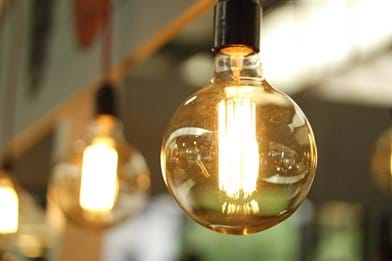
Appliances and white goods
- What should I look for when choosing appliances?
Look out for the energy label. This is a simple colour coded label that tells you how much energy that appliance uses, comparing it to similar appliances.
- How do energy labels work?
- Appliances are tested to find out how much energy they use during typical use. This gives them a rating on a scale of A to G, with A being the most efficient product of its class, and G being the least efficient. Some appliances use an older scale, from A+++ to G, with A+++ being the most efficient.
- You should also think about the size of the appliance you need.
Cooking
- Traditional cookers, whether they are integrated, freestanding or ranges, powered by gas, electricity, or oil, all consume a great deal of energy. New ovens have energy rating labels to help you make the right choice. The highest rated gas and electric ovens are A+++. You can buy a self-cleaning oven which has a pyrolytic function which is an easy way of cleaning but can contribute to higher running costs.
- Microwave ovens heat your food rather than the space inside the oven so can be a cheaper way of cooking. You can buy convection microwaves that brown your food – check the labels before you buy.
- Many people now use an air-fryer which, depending on their specification, can roast, grill, fry, or steam, and have found these to be a more cost-effective way to cook.
Fridges, freezers, and fridge-freezers
- Arguably the most essential of our home appliances, these are switched on 24 hours a day, seven days a week, and are some of the longest lasting appliances in our homes, so it’s worth finding energy efficient models. That means studying the energy labels and choosing a higher rated fridge or freezer for a significant impact on your running costs. The Energy Saving Trust estimates that choosing a A-rated fridge freezer over a F-rated unit will save you about £800 (670kgCO2e) in energy bills over the 17-year lifetime of the product.
- However, as the energy rating is categorised by size, choosing a smaller fridge will use less energy than a larger fridge with the same energy rating, and may even use less than a higher rated one. You can compare the total energy consumption of appliances by looking for their yearly energy consumption in kWh/annum – it’s displayed under the rating scale on the energy label
- Two different sized appliances with the same energy rating might use different amounts of electricity. For instance, a standard G-rated 265-litre fridge freezer could cost around £100 a year to run (60kgCO2e). A large American -style 424-litre fridge freezer with a better F rating could cost around £105 (65kgCO2e) a year to run.
- You can also make small changes to the way you cook, such as using a lid on a saucepan, as this will use less energy and have the added benefit of reducing the likelihood of condensation building up in your home.
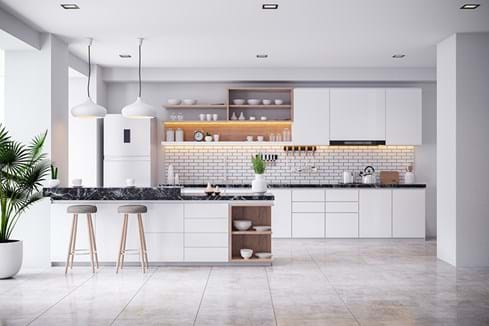 Dishwashers
Dishwashers
- A luxury that many of us would be reluctant to give up, the Energy Saving Trust estimates that almost 8% of our annual electricity bill is spent running the dishwasher.
- It typically costs between £50 to £100 (30 to 60kgCO2e) a year to run a standard sized dishwasher and between £40 to £75 (25 to 45kgCO2e) a year to run a slimline dishwasher. You’d still use energy to heat your water if you chose to wash up by hand though.
- The most efficient dishwashers have an A rating, and cost around £45 less per year (28kgCO2e) to run than the lowest rated dishwashers of the same size, and they use less water, which represents a cost saving if you are on a water meter, as well as being beneficial to the environment.
Kettles and coffee machines
- Kettles are one of the most used appliances in the kitchen. Are you guilty of boiling more water than you actually need?
- Buying a kettle that can just boil the amount of water required can use 20% less energy than a conventional electric kettle, or you can just avoid overfilling and save yourself £13 a year on your electricity bill (8kgCO2e).
- Coffee machines and kettles all have energy labels so again, it pays to do your homework.
Laundry appliances
- An energy efficient washing machine will save you money on your electricity bill and, if you have a meter, on your water bill too.
- Washing machines use an energy label scale of A to G. The Energy Saving Trust estimate that choosing an A-rated washing machine over a D-rated one could save you around £130 (100kgCO2e) over its 11-year lifetime. Try to wash only when you have enough laundry for a full load, or select a half-load programme, and wash at a lower temperature – most modern detergents are effective at 30 degrees.
- The cheapest way to dry your clothes is outdoors on a washing line but that’s not always feasible.
- Many people dry wet washing indoors on radiators or airers which is also cheap and easy but bear in mind that all the water from your clothes will transfer into the atmosphere. This moisture lands on cold surfaces like windows, walls and ceilings and can cause condensation, damp, and dangerous mould. You’ll need to increase the temperature, the amount of ventilation and maybe even run a dehumidifier.
- Tumble dryers use an energy label scale of A+++ to D. Choosing an A+++ rated one over a B-rated could save you around £980 (770kgCO2e) over its 13-year lifetime according to the Energy Saving Trust.
- Some tumble dryers are fitted with sensors prevent your laundry over-drying.
- You can buy dryers that vent to external air which is a good way to prevent condensation if your dryer can be placed on an external wall. Alternatively, you might choose a condensing dryer that collects the water.
- Electric heat pump tumble dryers are the most efficient: They recycle the heat from the ventilation tube back into the dryer after removing the water vapour from the air, reducing condensation, and saving energy, but they are more expensive to purchase.
Televisions
- Televisions can be the most power-hungry of all entertainment equipment, particularly the largest ones. The larger a television screen, the more energy it will consume, regardless of its energy rating.
- Even the most efficient 60” television is still more expensive to run per year than the lowest rated 32” television. By choosing a smaller television, you are generally saving more energy.
- Power consumption is mostly dependent on level of brightness and hours of use. After selecting the smallest TV still suitable, the best ways to save energy are to reduce brightness settings to your lowest acceptable limit and remember to switch off your TV when not in use.
- Some TVs incorporate energy saving features like automatic light sensors to detect the room’s brightness and adjust the screen accordingly and sleep timers to switch off the TV after a number of hours of no interaction.
Visit the Energy Saving Trust’s website for more information about choosing a TV
Computers, laptops, PCs, and tablets
- Typically a laptop uses 65% less electricity over a year than a desktop PC. Choosing a laptop over a desktop and avoiding leaving the laptop in standby could save up to £45 per year (25kgCO2e).
- Tablets have even lower energy usage – on average, tablets use 70% less power than laptops. Don’t leave them charging all the time though.
Smart speakers
- Smart speakers are relatively inexpensive to run, generally costing around £8 per year (5kgCO2e) - most of that cost is from keeping them on standby.
Do you leave appliances on standby?
- Standby means leaving an appliance like a television, or a washing machine plugged in and ready to use rather than unplugging completely. According to the Energy Saving Trust, The average UK household spends £65 a year powering appliances left on standby. That’s 40kgCO2e.
- As well as standby power used by appliances, we all have so many other devices now in our homes that use low levels of electricity when not actually being used. Think about items like printers, Wi-Fi modems and routers, smart speakers, sound bars, digi-boxes, and telephones. These appliances collectively consume a great deal of electricity as they are powered up 24 hours a day. You can now buy standby savers that allow you to turn all your appliances off standby in one go. Some come with timers and others come with a single off-switch.
Read more articles
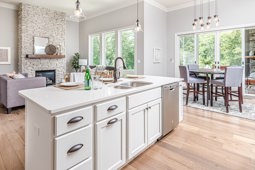
What to consider when creating a new open plan kitchen– Ask Anna Question of the Week
Read article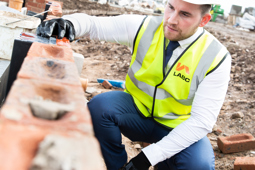
Do I need building regulations approval for my kitchen?
Read article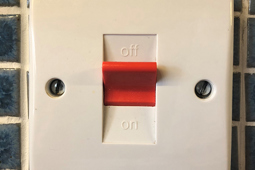
What electrical requirements are there for my kitchen project?
Read article